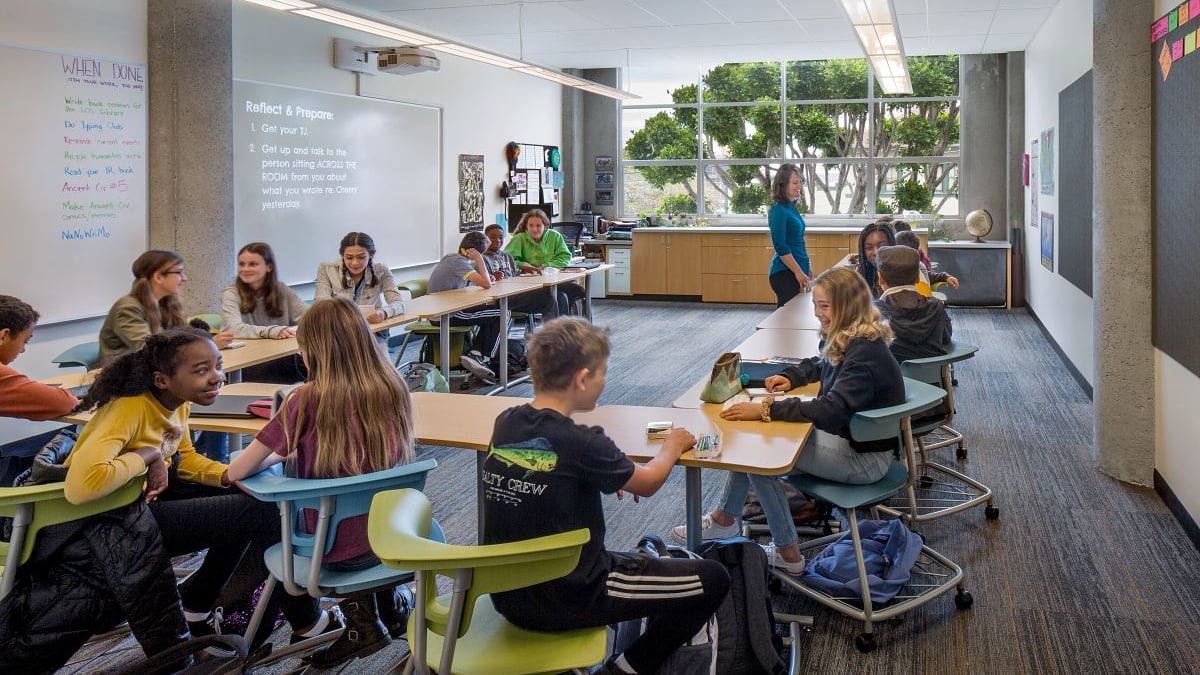Discover eight Performance Design Considerations for K–12 classroom design that reduce stress, boost engagement, and support every learner.
Today’s K–12 classrooms can’t be built with yesterday’s checklists.
Designing for learning outcomes isn’t about selecting chairs and desks that happen to fit a room—it’s about creating a classroom ecosystem that actively reduces stress, nurtures participation, and unlocks deeper engagement.
Guided by research and market insights, KI has identified eight Performance Design Considerations. These interdependent principles orbit one central goal: student success. They transform abstract aspirations like equity and well-being into measurable design levers that empower schools and educators to adapt and thrive.
In this blog, we’ll unpack each consideration, showing you how to apply them to create environments where every student feels supported, engaged, and ready to learn.
Why a Performance Framework?
Prescriptive checklists freeze design in time. They dictate solutions instead of enabling progress.
Performance standards, by contrast, define what student success looks like and allow education teams to iterate toward those results. The payoff is agility: furniture becomes micro-infrastructure you can reconfigure as pedagogy, demographics, or wellness needs evolve.
Take emotional safety. It flourishes when the room signals respect, calm, and belonging—conditions tied to lighting, acoustics, temperature, and flexible furnishings. A framework built around outcomes keeps the focus where it belongs: on the learner.
Featured products: MyPlace Ottomans
The 8 Performance Design Considerations for Learning Spaces
1. Accessibility
Accessibility isn’t a minimum threshold—it’s an ethic of opportunity. Removing physical, sensory, and cognitive barriers empowers every student to participate and succeed. Clear sightlines, adjustable surfaces, intuitive layouts, and inclusive digital tools ensure no learning space is “only as good as its least accessible corner.”
Featured products: Ruckus Stacking Desk, Intellect Wave Chair, Ruckus Whiteboards
2. Environmental Comfort
One-size-fits-all classrooms are fading. Comfort today means supporting varied postures, sensory preferences, and visual calm that reduce dysregulation. A coherent aesthetic—color, texture, and finish—creates a learning atmosphere where both students and teachers can thrive. Aging or standardized furnishings, by contrast, amplify discomfort and distraction.
Featured products: Intellect Wave Chairs, Ruckus Post-Leg Desks, Ruckus Activity Table, Ricochet Stools
3. Ergonomics & Movement
Furniture should fit bodies and tasks, not the other way around. Ergonomic design links directly to posture, focus, and reduced strain. Modern classroom furniture balances comfort and control, conserving energy for learning instead of fighting discomfort. Movement isn’t disruptive; it’s essential.
Featured products: (L) Cogni Chair; (R) Ricochet Stools
4. Multisensory Modulation
We learn through all our senses. Environments that tune sound, visual load, tactility, and opportunities for motion help students stay regulated and engaged. For learners with sensory differences, this intentional design isn’t just supportive—it’s transformative.
Featured products: Imaginasium Blocks & Blips, Ruckus Activity Table, Ruckus Whiteboards, Ruckus Storage
5. Physical Safety & Security
Safety doesn’t mean hardening an experience. Research shows that “softening” strategies—welcoming finishes, orderly layouts, and calming furniture—reinforce both physical and psychological security. Clean, well-furnished spaces communicate safety and allow academic focus to flourish.
Featured products: Tattoo Slim Seating, Athens Booth Table
6. Emotional Safety & Belonging
When students feel safe to speak and explore without fear, their thinking brains engage. Furniture that reduces visual noise, signals calm, and provides choice in seating helps create environments of trust, respect, and belonging.
Featured products: (L) MyPlace Modular Lounge, C-Table Personal Worksurfaces; (R) Sway Lounge Chair
7. Community & Connection
Learning spaces should reflect the people who inhabit them. Design that celebrates community identity, encourages collaboration, and fosters representation deepens engagement and shared purpose. When a room feels like it was built for “someone else,” students hesitate to linger, play, or grow there.
Featured products: MyPlace Modular Lounge, MyPlace Ottomans, Ruckus Chairs, Ruckus Activity Tables
8. Sustainability & Stewardship
Durability and adaptability aren’t only fiscally responsible—they model care for the planet. Stakeholders demand transparency about environmental impact, lifespan, and reuse potential. Furniture built for longevity, repairability, and flexibility teaches stewardship through everyday practice.
Featured products: LimeLite Cafe Stools, Ruckus Activity Tables, MyPlace Lounge Seating, C-Table Personal Worksurface
How to Apply the Performance Design Considerations to Your Classroom Design
The Performance Design Considerations are more than a framework—they’re a roadmap for your learning environments. Here’s how to begin:
-
Start with Learner Needs
Identify barriers in your current space—whether sensory overload, limited flexibility, or lack of mobility. -
Pick One Priority Standard
Focus on the consideration that will create the biggest impact. You can expand over time. -
Leverage Furniture as Infrastructure
Don’t just design for aesthetics. Choose pieces that support well-being, adaptability, and movement. -
Tell the Story with Evidence
Use classroom observations, student feedback, or measurable outcomes to guide decisions and demonstrate results. -
Design for All
Ensure every choice reflects inclusivity. Representation matters for engagement and belonging.
Featured products: Intellect Wave Chairs, Intellect Wave Task Stools, Pirouette Tables
Evidence, Not Guesswork
KI’s research, including insights from previous classroom furniture giveaways, shows the powerful link between environment and student outcomes. Students themselves reported feeling more comfortable, engaged, and supported when their spaces were intentionally designed with their needs in mind.
These eight Performance Design Considerations position environment and furniture as strategic tools for delivering accessibility, comfort, safety, connection, and sustainability. Whether you’re reimagining a single classroom or an entire school district, the process is the same: start small, measure honestly, iterate boldly.
This classroom design framework is more than theory. It’s tested, proven, and adaptable. Designing for outcomes starts with intention—and that’s how we create learning spaces where students truly thrive.



















